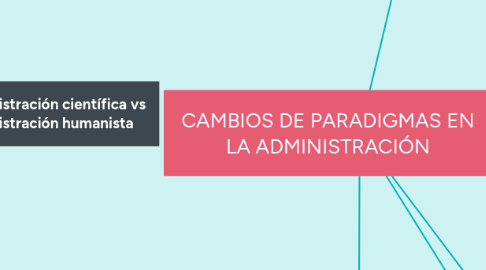
1. Nuevos valores en la Administración -Nuevas técnicas necesarias-Valores Clásicos y Nuevos.
1.1. En este campo axiológico el académico argentino Enrique Herrscher (2013: 21-23) 1 Selección de los valores propios que pueden contribuir a una sostenibilidad y sustentabilidad en las empresas en el siglo XXI. A los valores tradicionales de la era de la administración científica
1.1.1. Adicional a eso otros valores: confianza, reputación, innovación, persistencia. Flexibilidad, Anticipación, Innovación, Aprendizaje y Re conversión.
2. Administración científica vs Administración humanista
2.1. Taylorismo/Esfera de la administración
2.2. Organigrama vertical-paramidal
2.3. Mando-obediencia
2.4. Vigilancia rígida
2.5. Económico-Financiero
2.6. Capital-dinero
2.7. Fbrica propia-Multiplantas
2.8. Taylorismo/Esfera de la economía
2.8.1. Individualismo
2.8.2. Maximización de utilidad
2.8.3. Equilibrio de demanda y oferta
2.9. Comparaciones basadas en la administración y en la economía
2.9.1. Era Digital/Esfera de la administración
2.9.2. Red de redes- Aplanada
2.9.3. Autoridad-Consenso
2.9.4. Empoderamiento
2.9.5. Conocimiento-Información
2.9.6. Gestion del cambio-Innovación
2.9.6.1. Era Digital/ Esfera de la economía
2.9.6.1.1. Solidaridad/Reciprocidad
2.9.6.1.2. Economía del bien común
2.9.6.1.3. Desarrollo de personas-comunidad
2.9.7. Capital humano-Desarrollo de persona
2.9.8. Equipos multifuncionales
2.10. Social-Conectivo (Alianzas-Socios estratégicos)
3. "Cuanto mas sabemos, menos sabemos" Actores/Institución, Mercado/Empresa, Estado/Gobierno, Conocimiento/Universidad.
3.1. M&A?
3.2. Risk Analysis & Mitigation
4. Adm. Científica (Taylor y Fayol)
4.1. Realizaron estudios en base a la administración científica.
4.2. Buscaban eliminar las perdidas de tiempo, dinero y materiales para aumentar la producción.
4.3. Selección y entrenamiento científico del obrero.
4.4. Para Taylor había cuatro principios básicos de la Administración Científica
4.4.1. 1. Estudiar científicamente el trabajo a cargo de especialistas.
4.4.2. 2. Selección y entrenamiento científico del obrero (según aptitudes y actitudes.)
4.4.3. 3. Unificar el estudio del trabajo y la selección científica del operario.
4.4.4. 4. Lograr la cooperación entre los dirigentes y empleados, buscando una cooperación que refuerza la solidaridad humana.
5. Adm. Humanista (Ducker y Zamagni)
5.1. Cambios, conocimientos a través de investigaciones por la Internet, transformando e innovando los mismos.
5.1.1. Situational Analysis / Drivers
5.1.1.1. What is driving us to do this?
5.1.1.2. SWOT Analysis
5.1.1.2.1. Strengths
5.1.1.2.2. Weaknesses
5.1.1.2.3. Opportunities
5.1.1.2.4. Threats
5.1.1.3. Customer Findings - What have we learned from customers?
5.1.2. Competitive Analysis
5.1.2.1. Do we have competitors and threats in these target markets with the proposed offerings?
5.1.2.2. What are our competitors doing and how are they positioning?
5.1.2.3. How do we position against each competitor?
5.1.3. Target Customer(s)
5.1.3.1. Buyer Profile
5.1.3.1.1. Title
5.1.3.1.2. Industry
5.1.3.1.3. Geography
5.1.3.1.4. Business Size
5.1.3.2. Influencer Profile
5.1.3.3. User Profile
5.1.3.4. What do customers want and need?
5.1.3.5. What business problems do each of these customers have?
5.1.4. Customer Segmentation
5.1.4.1. Which customers or sets of customers do we sell to?
5.1.4.2. What are the target market segments that we want to go after?
5.1.4.3. What are the distinct problems for each segment of the market?
5.1.5. Total Available Market
5.1.5.1. New Prospects
5.1.5.1.1. How much of each target segment have we penetrated?
5.1.5.1.2. How much opportunity is available in each target segment?
5.1.5.2. Existing Customers
5.1.5.2.1. Can we up-sell existing customers?
5.2. Política: Transparencia y ejemplaridad
5.2.1. Service Offer
5.2.1.1. What are we selling?
5.2.1.2. Product Definition
5.2.1.3. Pricing
5.2.1.4. Packaging
5.2.1.5. Positioning
5.2.2. Value Proposition
5.2.2.1. What is the Value Proposition to the Customer?
5.2.2.2. What pain are we solving?
5.3. Económico: Organización y Viabilidad
5.3.1. Revenue Forecasts
5.3.1.1. Revenue and P&L Forecast (5 Years)
5.3.1.2. Revenue should be split out quarterly
5.3.2. Cost Analysis
5.3.2.1. Should include a description of the costs in entering this business and profitability analysis
5.3.3. Profitability Analysis
5.3.3.1. P&L for the offer to include gross margin, net income and break even analysis.
5.4. Empresarial: Éxito, Innovación y Liderazgo
5.4.1. Sales Strategy
5.4.1.1. Direct Sales Strategy
5.4.1.2. Inside Sales Strategy
5.4.1.3. Channel Sales Strategy
5.4.2. Partner Strategy
5.4.2.1. Channel Strategy
5.4.2.1.1. What 3rd party channels should we consider for reselling this service?
5.4.2.2. Technology Partnerships
5.4.2.2.1. What technology vendors (if any) do we need to work with to execute on this plan?
5.4.2.3. Solutions Partners
5.5. Social: Acceso a información, noticias y relaciones internacionales.
5.5.1. Positioning & Messaging
5.5.1.1. What is the key messaging and positioning for the service offer? (Pain, alternatives, solution)
5.5.1.2. How do we communicate internally?
5.5.1.3. How do we communicate externally?
5.5.2. Promotion Strategy
5.5.2.1. Marketing Programs (Installed base versus new prospects)
5.5.2.2. Advertising (Publications, etc.)
5.5.2.3. Analyst Relations (Target Analysts)
5.5.2.4. Public Relations
5.5.2.5. Events (Trade shows, SEO/SEA, Seminars)
5.5.2.6. Webinars
5.5.3. Demand Generation & Lead Qualification
5.5.3.1. How do we generate and qualify new leads for the target offer?
5.5.3.2. Prospect Lists
5.5.3.3. Key Questions to Ask
5.5.3.4. Sales Collateral
5.5.3.5. Presentations
5.5.3.6. Data Sheets
5.5.3.7. White Papers
5.5.3.8. ROI Tools
5.5.3.9. Other Sales Tools (web site, etc.)
5.6. Medio Ambiente: Evitar catástrofes y disminuir costo de vida humana.
5.6.1. Numbers, budget, waterfall, break-even (cost>leads>trials>deals)
5.6.2. Sales Programs
5.6.3. Accelerated Learning Strategy, Controls, Metrics
5.6.4. Include feedback loops
5.6.5. Include financial metrics (definition of success)
5.6.6. Pipeline reports, etc…

